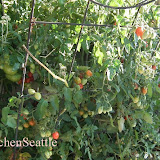Check out this chef's knife training video from Melbourne
If you love cooking, your kitchen knife is one of the most important tools in your kitchen.
After I read cooking basics books and internet what other chefs tell about using kitchen knives, I found 6 safety tips which are common sense but are useful in addition to watching my fingers and my knife.
1. Keep your kitchen knife sharp.
Dull knife slips and cut something else than what you want to cut. You can test if your knife is sharp by moving back and forth on the cutting board. If your knife cut into the board and is hard to move, your knife is sharp. If your knife moves easily, your knife is dull and need to be sharpened. Some Sushi chef tests his/her knife on his/her thumb nail. Please don’t try it.
2. Do not walk around with your knife. When you need to carry your knife, hold it by your side.
When Japanese chef carries his sharp knife, He will put his hand o over the knife and tell people around him that he is coming with his knife.
3. Never point at your knife every one
4. Do not try to catch a knife when you drop it.
Blade is heavier than the handle and goes down first and dangerous. From old book of “Cutting-up in the kitchen. The butcher’s guide to saving money on meat & Poultry by Merle Ellis”, if you drop a knife or it gets knocked off the counter, throw your hands in the air, as if somebody had a gun in your ribs, and let it fall…..
5. Never leave your knife in soapy water or a sink full of water.
Someone wash dishes and may cut his/her hand. Knife need to be kept at the location where everyone can see.
6. When you pass a knife to someone, put it on a cutting board and let another person pick it up.
Kitchen knife need to stay on the cutting board unless it is washed or put away.
YouTube video Above is from Melbourne production and I used some tips from it. I liked it the best among many knife skill videos.
Tuesday, September 27, 2011
Kitchen knife Safety
Tuesday, September 6, 2011
Fresh out from own backyard
 |
| Vegetable Garded |
There are a large Grape vine by a gate to the Prune kitchen, raspberries, green beans Japanese pepper plants, Shiso(Japanese fragrant green leave), Mint, Rosemarie, and Sage in side yard, , cherries, Rhubarb, cabbage, tomatoes, Chinese chives and green onion in the backyard. The new residence with the Prune kitchen get more sun shine than my previous house. Last fall, I dag the rocky and hard ground around Prune Kitchen, added many bags of composed and organic fertilizers, and planted vegetables. My hard labor paid off and I have vegetables in my garden. Tomatoes start ripening two weeks ago and until Seattle’s rainy fall starts, I will have enough fresh tomatoes for my everyday salad.
Beginning this summer,when I trimmed overgrown grape vines, I realized that I can save some tender fresh grape leaves to make stuffed grape leaves(Dolmathakia Me Rizi.) I searched the recipe and made some for my family and cooked with members of “Seattle let us cook together meetup.” The Dalmathakia Me Rizi was interesting taste to me while meetup members who cooked and ate dalmathkia said it was very delicious. We made as many as 60 of them and they were gone. Here is how I made dalmathakia Me Rizi.
I cooked fresh leaves using Grape Leaves-Canning recipe from food.com .
Then I used some of cooked leaves and a recipe from Greekcuisine.com to make Dolmathakia Me Rizi. As you see the recipe, it contains too much oil and I reduced oil amount to a half of the recipe and steamed instead of boiling.
Lastly useful fresh herbs are Rosemarie and green onion. It enhance the taste of pork dish and add nice aroma and flavor to the pasta dish when cooked it with Tomatoes and chili flakes. Green onion is for Japanese soup and add color to the salad.

Labels:
fresh vegetable,
Garden,
herb,
home grown,
seasonal
Subscribe to:
Posts (Atom)


